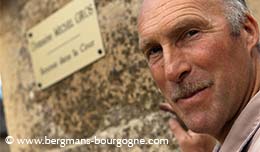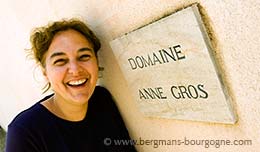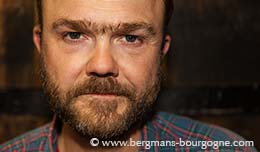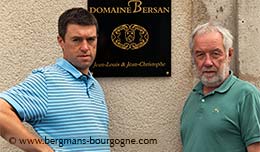
aurent Fournier in Marsannay knows his village. He produces 21 different wines. With a few exceptions, they all come from Marsannay.
– Already when my father took on the domaine in 1960 there was a lot of Marsannay, he says. At the time the wine from Marsannay did not have the best of reputations, but it sold well in the area. It may sound like a bit of a contradiction, but that is how it was.
Today’s Domaine Jean Fournier covers 16.5 hectares, with an additional 4.5 hectares not yet planted. When Laurent’s father Jean ran the domaine the rosé accounted for more than a quarter of the production. Since then it has shrunk to just three per cent.
 Laurent Fournier arrived at the domaine in 2001. He has converted the domaine to organic practices. Harvest is now done entirely by hand and the yields are lower. Vinification using whole bunches has been introduced and the élevage is generally longer.
Laurent Fournier arrived at the domaine in 2001. He has converted the domaine to organic practices. Harvest is now done entirely by hand and the yields are lower. Vinification using whole bunches has been introduced and the élevage is generally longer.
– My father preferred more extracted wines than I do, says Laurent Fournier. So there has been a change there as well. But the Fournier style is still there. I’m very fond of concentrated wines.
Domaine Jean Fournier produces only one aligoté – or two, depending on how one sees it. The first one is from two old parcels in Champ Forey, just northeast of the village.
 – Even if aligoté doesn’t sell very well I wanted to keep the two oldest parcels of the domaine, explains Laurent Fournier. I believe there is a lot of potential when it comes to quality there. In the old books, like Danguy & Aubertin, Lavalle etc, the aligoté was highly regarded. It doesn’t have a strong personality in itself, but if it’s grown with care I’m sure it will express the terroir very well.
– Even if aligoté doesn’t sell very well I wanted to keep the two oldest parcels of the domaine, explains Laurent Fournier. I believe there is a lot of potential when it comes to quality there. In the old books, like Danguy & Aubertin, Lavalle etc, the aligoté was highly regarded. It doesn’t have a strong personality in itself, but if it’s grown with care I’m sure it will express the terroir very well.
The second one, a cuvée called ”S…?!?”, does have Bourgogne Aligoté on the label, but is made entirely from sauvignon grapes.
– Sauvignon is not allowed, so officially it’s aligoté, Laurent Fournier says with a mischievous smile. I was curious to see how it behaved in the Côte d’Or. They are relatively young vines, planted in En Mechalot, just in front of the village. Half is in barrels, with malolactic fermentation, half is in tank, with the malolactic fermentation blocked.
 Another peculiarity of the domaine is the Origines cuvée, up until 2014 called Les Avoines since all grapes then came from that particular lieu-dit in Marsannay. Those grapes are now blended with grapes from the Hautes-Côtes near Échevronne.
Another peculiarity of the domaine is the Origines cuvée, up until 2014 called Les Avoines since all grapes then came from that particular lieu-dit in Marsannay. Those grapes are now blended with grapes from the Hautes-Côtes near Échevronne.
– This is mainly pinot blanc, with a bit of pinot beurot (pinot gris). No chardonnay at all. You are allowed to plant and make a 100 per cent pinot blanc. The pinot beurot is different. In Marsannay you are allowed to use it, but not for white wine. Just for Marsannay rosé. I think Les Avoines benefitted from being blended with the later ripening parcel in Échevronne. It gives the wine a better balance.
Laurent Fournier describes the Marsannay appellation as consisting of four sectors. There is the northern end of the appellation, in the commune of Chenôve, with Clos du Roy and Le Chapître. These are early ripening, producing powerful and structured wines.
 – Then you have the valley coming down from the Hautes-Côtes just north of the village of Marsannay, says Laurent Fournier. It’s a large part of the appellation. The wines are more easy-drinking. Behind the village you have a slope which produces wines with elegance and finesse. Finally you have the southernmost part of the appellation, a small sector in Couchey bordering on Fixin. Tasted blind these wines can easily be mistaken for Fixin wines. Champs Perdrix here is a bit special as it is higher in altitude than parts of the Hautes-Côtes.
– Then you have the valley coming down from the Hautes-Côtes just north of the village of Marsannay, says Laurent Fournier. It’s a large part of the appellation. The wines are more easy-drinking. Behind the village you have a slope which produces wines with elegance and finesse. Finally you have the southernmost part of the appellation, a small sector in Couchey bordering on Fixin. Tasted blind these wines can easily be mistaken for Fixin wines. Champs Perdrix here is a bit special as it is higher in altitude than parts of the Hautes-Côtes.
For both red and white Marsannay Laurent Fournier has singled out the potential future premier crus like Clos du Roy, Longeroies and Es Chezots (spelt Les Echezeaux by other growers). The remaining lieu-dits and parcels with young vines go into the two Saint-Urbain cuvées.
 – The vines in Es Chezots are between 30 and 65 years old, says Laurent Fournier. It is right in the valley coming down from the Hautes-Côtes. It’s stony, flat and always a bit of wind. The wine gets tannins which are a bit foursquare. Not so much fruit, more flowers and spices.
– The vines in Es Chezots are between 30 and 65 years old, says Laurent Fournier. It is right in the valley coming down from the Hautes-Côtes. It’s stony, flat and always a bit of wind. The wine gets tannins which are a bit foursquare. Not so much fruit, more flowers and spices.
Further out in the valley, but up on a gentle slope is Longeroies. Laurent Fournier makes both a red and white version of this one.
– The pinot noir vines are between 50 and 70 years old, he says. I have almost five hectares of pinot noir there. Longeroies is different from Es Chezots. The soil varies in depth, but the bedrock is never far away. The wines are complex, with more black fruit and fat. They are rounder and more generous.
Outside Longeroies, where the slope turns up towards Chenôve, facing more straight east, is Clos du Roy. With Dijon expanding over the years there are few vineyards left in the commune of Chenôve. Apart from Clos du Roy and Le Chapître, the latter only regional appellation, there are not many vineyards.
 – In Clos du Roy we are on Comblanchien limestone, whereas in Longeroies we are on Premeaux limestone. Clos du Roy needs more time to open up. But when it does it has more length than Longeroies, which is a rounder wine.
– In Clos du Roy we are on Comblanchien limestone, whereas in Longeroies we are on Premeaux limestone. Clos du Roy needs more time to open up. But when it does it has more length than Longeroies, which is a rounder wine.
Marsannay ”P’tite Grumotte” and Marsannay ”Pur Pôt” are two tiny cuvées of Domaine Jean Fournier. They were created the celebrate the births Laurent’s two children, Pauline in 2011 and Charles in 2012. Only 600 bottles are produced of each cuvée every year.
– P’tite Grumotte comes from three parcels – two in Longeoies and one in Ouzeloy – which are often affected by millerandage, with very small grapes as a result. I use seven or eight of my best harvesters, but we still need a whole day to bring the seven or eight hectolitres required for this cuvée. It is completely de-stemmed and the result is a very concentrated wine.
– Pur Pôt comes from a single parcel in Clos du Roy. It is my oldest vines in Clos du Roy and it is the part which has the most limestone.
© 2017 Ola Bergman














